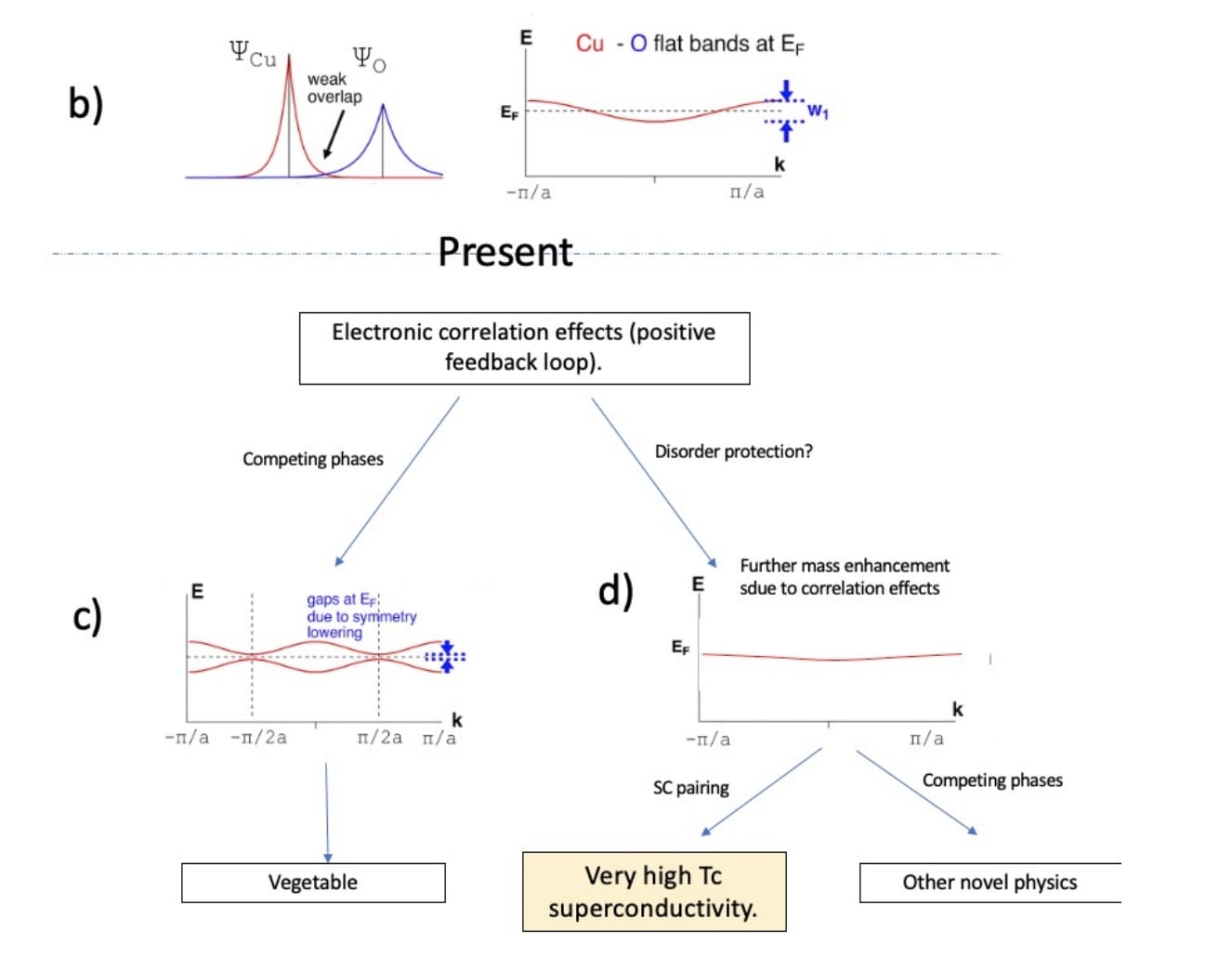University Colorado researchers calculated that the class of LK99 material (weak interaction of Copper‒Oxygen, while minimizing hybridization) shows promise for high temperature superconductivity regardless of LK-99 actually working.
They found through DFT (Density Function Theory) calculation that flat CuO bands in Cu-doped Pb apatite (LK99) is generally consistent with the statement in that this kind of system can (or may be) supporting superconductivity to very high temperatures.
This is because such flat bands and their associated high density of states are generally strongly favorable for superconductivity, which in BCS theory exponentially varies with the density of states at EF. That is, a host of nearly degenerate electrons, with high density of states over the entire Brillouin zone might significantly gain energy by pairing up and gapping out the Fermi surface, i.e. creating a superconducting phase. However, it does not eliminate the possibility for the system to choose some magnetic or charge ordered phases that will compete for those same states, lowering or fully quenching the superconductivity. It requires a more careful analysis of all possible competing instability-channels to explore what the material chooses as its ordered ground state. Extremely flat states at the Fermi energy can also significantly enhance the electron-phonon coupling matrix elements, which would also support higher superconducting transition temperatures. In contrast with the hydride superconductors, the phonon modes are less violent for oxygen and copper and may not need high pressures to prevent the system from falling apart. The presence of disorder and flat electronic states together suggest the material may choose an s-wave superconducting phase. Most importantly, the Cooper pairing in that case will probably be better described by a strong coupling picture akin to the BEC limit.
Based upon density functional theory (DFT) calculations, researchers present the basic electronic structure of CuPb9(PO4)6O (Cu-doped lead apatite), showing that the low energy (near-Fermi level) states are dominated by Cu-O hybrid states. The filling of these states is nominally d9, consistent with the standard Cu2+ valence state. We find these states to be unusually flat (~ 0.2 eV dispersion), giving a very high density of electronic states (DOS) at the Fermi level that we argue can be a host for novel electronic physics, including potentially room temperature superconductivity. The states are in general sensitive to symmetry-lowering gapping possibilities that would remove the spectral weight from EF, but could be protected from this by disorder/doping heterogeneity in a real material. Importantly, this disorder is expected to be less damaging to superconductivity. Further, we claim that the emergence of these flat bands should be due to weak wave function overlap between the orbitals on Cu and O sites, owing to to the directional character of the constituent orbitals. Therefore, finding an appropriate host structure for minimizing hybridization between Cu and O while allowing them to still weakly interact should be a promising route for generating flat bands at EF and very high temperature superconductivity, regardless of whether LK-99 is such a realization.
Rafal Kurleto1,2,*,
Stephan Lany3,
Dimitar Pashov4,
Swagata Acharya3,
Mark van Schilfgaarde1,3,%,
Daniel S. Dessau1,2,3,
1 Dept of Physics, University of Colorado Boulder, Boulder, CO 80309
2 Center for Experiments in Quantum Materials, University of Colorado Boulder, Boulder, CO 80309
3 National Renewable Energy Laboratory, Golden, Colorado 80401
4 King’s College London, Theory and Simulation of Condensed Matter, The Strand, WC2R 2LS London, UK






Brian Wang is a Futurist Thought Leader and a popular Science blogger with 1 million readers per month. His blog Nextbigfuture.com is ranked #1 Science News Blog. It covers many disruptive technology and trends including Space, Robotics, Artificial Intelligence, Medicine, Anti-aging Biotechnology, and Nanotechnology.
Known for identifying cutting edge technologies, he is currently a Co-Founder of a startup and fundraiser for high potential early-stage companies. He is the Head of Research for Allocations for deep technology investments and an Angel Investor at Space Angels.
A frequent speaker at corporations, he has been a TEDx speaker, a Singularity University speaker and guest at numerous interviews for radio and podcasts. He is open to public speaking and advising engagements.


Lol. “Flaky”
Sometimes, there is a specific thing or condition that even escaped to the one who made the succesful prototype and nobody else does it because they don’t know either. Let’s wait and see.
Patience is a virtue.
Recall the history of YBCO superconductors first discovered in the 1980, 87 I think. It was a difficult material that had two phases; a black and a green one. I think it was the black phase that was eventually discovered to be the superconducting one. There was a lot of pessimism, and back and forth, but in the end YBCO is a superconductor and is used in some applications today. It’s brittle and hard to work with, but has found some application.
The article “Zero Resistance Measured in a New LK-99 Replication at Southeast University in Nanjing China” made me think of the history of YBCO. For LK-99, in the article it talks about a much colder critical temp (110K is not exactly a balmy room temperature) and a higher temp around 300K where the resistance drops a lot but not to zero. Then you have all the modeling studies and the discussion of the pb(1) and pb(2) binding sites and what that means. Some suggest binding to one site gives you a semiconductor and binding to the other site a superconductor. There seem to be multiple phases in the samples and the purity is poor, hense the YBCO in the early days analogy.
Time will tell. I do think it stimulates a lot of good research in any event.
Perhaps it will help them find room temp superconductors. Too many negative reviews, others are inconclusive. Kelvin resistance measurements are also not convincing.
Wow this is super positive news please keep up the good work
I want to see someone ride their sample round the lab like a hoverboard or I’m not having any of it.